Appointed by Ulysses Grant Political party Republican Party Role Judge | Name Lorenzo Sawyer | |
 | ||
Born May 23, 1820Le Roy, New York, U.S. ( 1820-05-23 ) Education Case Western Reserve University | ||
Lorenzo Sawyer (May 23, 1820 – September 7, 1891) was an American lawyer and judge who was appointed to the Supreme Court of California in 1860 and served as the ninth Chief Justice of California from 1868 to 1870. He served as a circuit judge for the U.S. Circuit Courts for the Ninth Circuit beginning in 1870 and later served as the first judge on the United States Court of Appeals for the Ninth Circuit from June 1891 until his death.
Contents

Early years
Sawyer was born on a farm in Le Roy, New York, the eldest of six children. He worked on the farm during the summer and attended the district school in winter. At the age of fifteen he attended, for a short time, a high school at Watertown, called the Black River Institute, where he became interested in the law. In 1837, having reached the age of seventeen, he went out on his own to pursue a course of study preparatory to commencing the study of law. The next eight years were devoted to preparation for the bar, at first in New York and afterward in Ohio. To support himself during this period, he taught in the district schools, and afterward in academies and as a tutor in college.
Career
In 1840 he emigrated to Ohio, where he pursued his studies for a time at the Western Reserve College, and afterward continued his studies at Columbus and at Ohio Central College near Columbus, graduating in 1846. He was admitted to the bar of the Supreme Court of Ohio in May 1846. He afterward went to Chicago, Illinois, where he passed a year in the office of future California Senator James A. McDougall. Soon afterward he entered into a law partnership with the Lieutenant-Governor John Edwin Holmes at Jefferson, Wisconsin, where he was rapidly acquiring an extensive and lucrative practice, when the California Gold Rush happened.
Joining a company of men from Wisconsin, he made his way across the country in seventy-two days, arriving in California about the middle of July 1850 in "an unprecedentedly short trip". He wrote sketches of this trip, which were published in the Ohio Observer, and copied into many of the western papers. They were highly appreciated and were used as a guide by many emigrants of the succeeding year. After working in the mines for a short time, he went to Sacramento and opened a law office there. Ill health, however, compelled him to seek the climate of the mountains, and accordingly he moved to Nevada City and entered upon the practice of law in October of that year, his law library consisting of eleven volumes which he had brought across the plains. With the exception of a few months from February to August 1851 passed in San Francisco, during which time his office was twice burned, he remained in Nevada City until the autumn of 1853, when he returned to San Francisco. In 1853 he was elected City Attorney as a nominee of the Whig Party. In September 1854, he was again nominated for City Attorney by the Whig and American Party, or Know Nothings.
In 1855 he was a candidate for Justice of the Supreme Court, and came within six votes of reaching the nomination. On March 6, 1861, he was admitted to the bar of the Supreme Court of the United States. In the spring of 1861 he formed a law partnership with the General C. H. S. Williams, and in the winter of 1861-62 they determined to open a branch office in Virginia City, Nevada. Sawyer went to Virginia City in January 1862 to open the office and establish the business, and while there Governor Leland Stanford of California offered him the appointment of City and County Attorney of San Francisco, which he declined. In June 1862, he was offered a vacant spot in the office of Judge of the Twelfth Judicial District, embracing the city and county of San Mateo, which he accepted, and he was unanimously reelected to office when his first term was up, both political parties giving him their support.
Upon the reorganization of the State courts, under the amended constitution, Judge Sawyer was in 1863 elected a justice of the Supreme Court of California, and drew a six-year term, during the last two years of which he was Chief Justice. During his term, he was noted for the thoroughness and elaborateness of his decisions and held in high regard.
In 1869, Congress passed an act to amend the judicial system of the United States, by which the United States Circuit Courts were reorganized—the appointment of a circuit judge for each of the nine circuits being provided for. In December of that year, as the term of Chief Justice Sawyer was about to expire, President Ulysses S. Grant nominated him to the United States circuit court for the Ninth Circuit (which later became the United States Court of Appeals for the Ninth Circuit). In January 1870, Sawyer was confirmed by the Senate. In 1884, he handed down what became known as the Sawyer Decision in Woodruff v. North Bloomfield Mining and Gravel Company which abruptly ended hydraulic mining in Northern California's Gold Country. He served on the court until his death in 1891.
Civic activities
In November 1885, he served as an original trustee of Leland Stanford Junior University.
